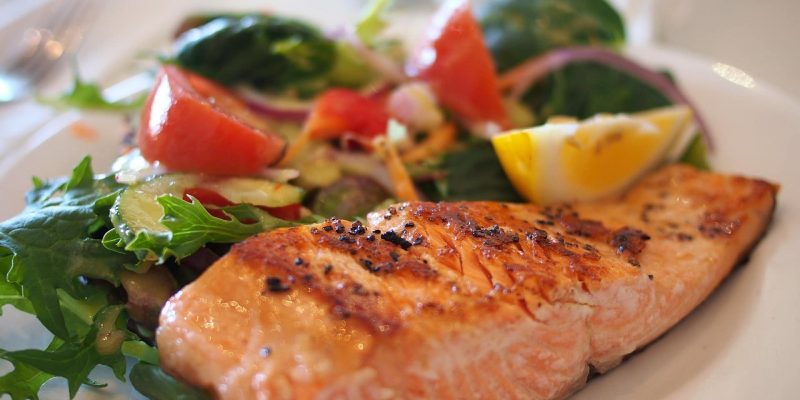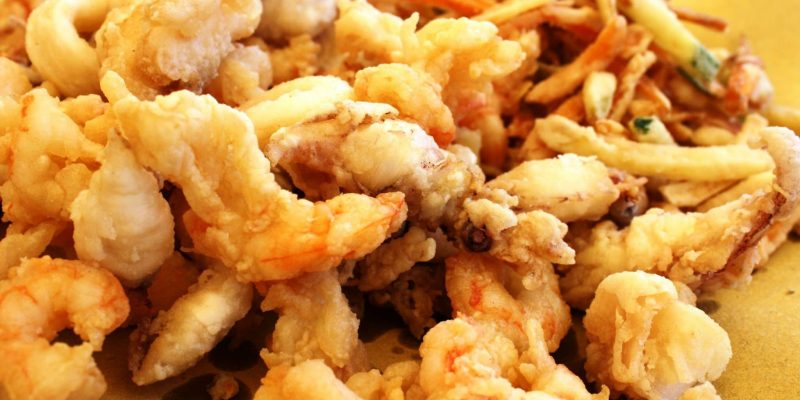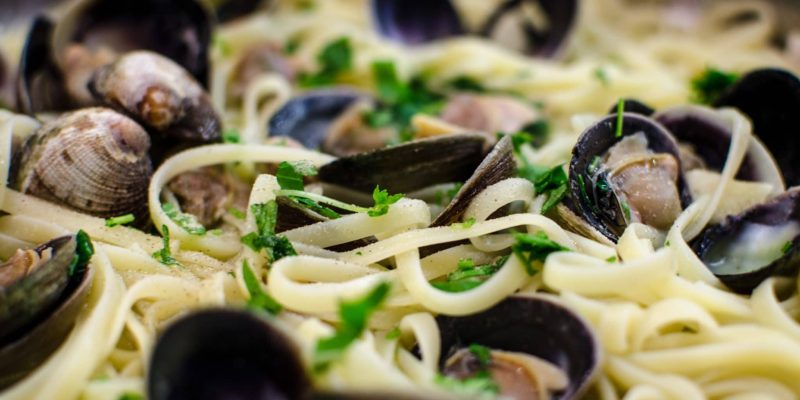Many traditions such as Christmas, Feast of the Seven Fishes (FotSF), Valentines Day and New Year, by definition, are fraught with beliefs, customs, and practices. And it could be practiced every week, every month, or every year. Now, one of the most celebrated traditions in the world today, one which goes beyond borders and crosses oceans, is Christmas.

Almost all the world celebrate it and for those areas that don’t celebrate this Christian holiday, they are most probably aware of it. And in some cultures, they even have their own version of it.
But even though many Christian countries celebrate it at around the same time, they don’t exactly have the same customs. For many Italian-Americans, as well as some Italians, however, there is one custom they certainly look forward to put into practice every Christmas season. And that is the Feast of the Seven Fishes, or shall we say La Festa dei Sette Pesci.
What is then this famous feast? To put it simply, it is the tradition of cooking and serving seven courses of fish and seafood dishes on Christmas Eve, something that’s highly popular in Italian-American families and communities in the United States, as well as in southern Italy. In fact, it’s been called a veritable frutta di mare celebration that many of those with Italian heritage look forward to every year.

Contrary to the tradition’s moniker though, the event is not strictly a celebratory feast like Carnevale, but more of a special seven-course (or more) dinner with lots of seafood. And for some families, their menu may not only have seafood but also vegetables, Italian sweets and pastries, and Italian wine.
Another thing you need to know is that there is no traditional set of seven fishes to be used for this particular occasion. More often, the types of fish typically used for the said feast are simply seven (or more) of the following fishes/seafood:
The custom of eating fish has been a long standing tradition in Italy for the holiday season. And this is true even on other religious holidays as well.
This practice denotes a fasting of sorts, a sacrifice. Hence the practice of abstaining from eating meat during Fridays leading up to the Holy Week, Christmas Eve, and other holy days.
For others, they consider it a preparation for the abundance on the actual feast day itself, which is Christmas Day. In fact, according to Rachel Ray, in Sicily, the said feast was also traditionally served on Christmas Eve after a 24-hour fasting period.
So imagine fasting for the entire day before Christmas Eve, indulging on seven or more seafood dishes on Christmas Eve itself, and feasting on all kinds of savory holiday meat dishes and sweets on Christmas Day.
It’s like easing your tummy into the eventual binge on the Big Day. Seems rational enough, right? We bet your palate wholeheartedly concurs.

There is some debate as to when and where the Feast of the Seven Fishes actually originated. Some declare it’s purely a variation of the age-old Italian tradition of serving meatless dishes on Christmas Eve. And that in the old country, a meatless (and dairy-less) feast that is celebrated in many regions is simply called La Vigilia or La Cena della Vigilia in Italian, which means “The Vigil” or “Christmas Eve dinner” in English. It symbolizes the wait leading up to the birth of the baby Jesus at midnight.
Others, however, argue that it’s actually an old tradition in southern Italy, particularly in Naples, Sicily, and Calabria.
They also say the customs tied to the tradition has been in existence there for centuries—feast name, numbers, and all. In fact, some theories play on the notion that the tradition dates back to a 4th century Roman Catholic tradition.
And that over the years, it has spread to other regions in the country, as well as to the United States, brought there by Italian immigrants.
And there’s also a theory that it’s a derivative of the Calabrian Christmas tradition called Il Cenone. The said tradition requires 13 dishes on the dinner table. The menu often includes not only seafood but also sweets. Now, Il Cenone is actually a tradition celebrated not just in Calabria, but all over Italy during New Year’s Eve. It literally means “the big dinner.”
One cookbook author mentioned that it may very well be a Pre-Christian tradition. And that it symbolizes celebration, instead of abstinence. It’s because in ancient Egypt, seafood was considered festive fare. Since there were only a few times in a year that the Nile River gets flooded and people would get fresh fish.
Over the centuries, as the influence of Christianity spread, the festivals used to celebrate the bounty of the sea actually evolved into Christian celebrations.
Whichever of the inception stories you may believe in, however, one of the things that’s constant is that it’s an occasion meant to be celebrated with family and a lot of good food.
So where did the number seven come from, you ask? Well, much like its origin, there are many theories surrounding the number seven in connection to the feast. Below are some of the popular theories, so far.

In other regions, and for some families, however, the feast doesn’t actually come with the magic number seven. There are those that associate the number nine to it instead. It is said to symbolize the Holy Trinity, multiplied by three.
Some declare that the correct number is ten, for the Stations of the Cross. There are also those that link the number 13 to it, which is practiced for Il Cenone, signifying the 12 apostles and Jesus Christ.
Typically though, many families don’t actually cook only seven kinds of fishes or seafood. Many also don’t prepare only seven traditional seafood dishes. Usually, Italian-American families have more than seven kinds of fish and seafood dishes for the occasion.
They also include other foods such as antipasti, pastas, and desserts… especially desserts. In fact, many Italian-American families typically include all kinds of pastries for the Feast of the Seven Fishes. Popular choices are cannoli and struffoli.
Some of the usual traditional Italian dishes served during the Feast of the Seven Fishes may vary from family to family. In Italy especially, it may vary even from one village, province, or region to another. According to some Italian-American chefs, however, the following are some of the most common fish and seafood dishes prepared for the said feast:

Translated in English to mean Fried Eels, it is exactly as its name implies. It is a highly popular traditional dish especially during the holiday season. To learn how to make some yourself, check the recipe below.

Much like Capitone Fritto, only so much better because of the variety, Fritto Misto di Mare is also a popular antipasto composed of mixed fried seafood. It typically has sardines, any fish fillet, shellfish such as mussels and scallops, and crustaceans such as soft shell crabs, shrimps, and prawns. It may also have mollusks such as squid, cuttlefish, or octopus.

This is basically a dish with any variety of vegetables, usually locally grown and ones that are in season, along with octopus, of course. The octopus is typically boiled in a lightly salted water, which may or may not have herbs and spices. In some variation of the recipe, the water may also contain wine.

This is a delightful primo pasta dish that combines the classic yumminess of spaghetti sauce with the sweet deliciousness of mussels. A veritable feast for the senses with its vivid colors, aromatic smell, and tangy sweetness of the tomatoes and shellfish, Spaghetti con le Cozze is something that will be a sure hit with your family, friends, and guests during the holiday season.

This may also be a seafood pasta dish but it is not exactly the same as Spaghetti con le Cozze. It uses a different pasta, a different shellfish, and has a different sauce.
The pasta you use for this dish linguine, which is a flat string pasta, and the shellfish is clam, which is bivalve mollusk that can both be found in fresh and salt water.
Aside from those things previously mentioned, this dish also usually needs wine, which make it more savory. If you don’t have linguine on hand, you can use spaghetti to make spaghetti alle vongole recipe.

A savory seafood dish typical in the Tuscany region, Anguilla Livornese is made with fried eels dredged in flour and with a sauce made of onions, tomatoes, and garlic cooked in butter. And before you serve it, garnish each plate with some chopped parsley and you have one delicious dish.

As its name suggests, this dish is from the beautiful coastal city of Naples that calls for salted/salt-cured cod fish, capers, tomatoes, olives, and parsley.
However, this dish also has quite popular versions in the regions of Veneto and Liguria. It is not only served during the Feast of the Seven Fishes but also during Lent.
Clearly, baccala is a favorite fish for many Italian families. If you’re interested in a recipe, check one version of it below.

Unlike most of the dishes in this list, many believe this was concocted in the United States by Italian immigrants.
However, it is considered to be a derivative of several traditional Italian dishes that continue to be popular today.
The recipe consists different kinds of seafood (fish, crustaceans, shellfish, and mollusks), tomato sauce or fresh diced tomatoes, and white wine. If you’re interested in a recipe, check the one below.

Another classic seafood Italian dish, Calamari Ripieni is basically stuffed squid. What kind of stuffing though? Well, the usual combo consists of eggs, anchovies, breadcrumbs, Parmesan cheese, as well as herbs and spices.
Some versions of this dish also have capers and olives. Simply describing the list of ingredients, doesn’t it already sound scrumptious?

The classic vegetable pasta from Naples, it simply consists of a sauce of pressed garlic and red chili flakes (tip: use this calabrian chili paste for the perfect kick!) in olive oil and a garnish of chopped parsley and grated Parmesan cheese.
To make it fit for the Feast of the Seven Fishes, however, you have to add some seafood, of course. And one the perfect fishes for Aglio e Olio is the flavorful anchovy. How? Simply add some anchovy flakes of fillets to the olive oil-based pasta sauce when you cook it. And you can even add some shrimp and coarse breadcrumbs to it, too!
Now, when making your menu, you can probably fill the antipasto, primo, and secondo dishes with any of the common seafood dishes most Italian and Italian-American families prepare for the FotSF. For suggestions, check the dishes mentioned further below. For the rest of the courses, however, below are some suggestions that may help you out.

A tangy slightly bittersweet cocktail, it is a concoction consisting of sparkling wine, perhaps Prosecco, club soda, and Campari, a red-colored alcoholic liqueur from Italy. It is usually served with green olives. Many wine experts believe it is the “forerunner” of the more popular Aperol Spritz.
It is the most popular aperitivo in Italy, especially in the northeastern regions. Much like Campari Spritz, two of its main ingredients are Prosecco and soda water. However, instead of Campari, you use Aperol, which is an orange liqueur made of gentian, rhubarb, cinchona, and bitter orange. It is usually served “on the rocks” and with a wedge or two of orange.
This cocktail usually consists of Angostura bitters, brandy, sugar, and of course, champagne. It is typically served in champagne flutes, with orange slices or Maraschino cherries as garnish.

A traditional food typical of the Puglia region, it is a simple vegetable dish made of sliced eggplants that are grilled or fried. They are then arranged on a dish, drizzled with some salt, olive oil, vinegar, and garlic, and garnished with finely chopped mint leaves.
A colorful but really simple contorno, it is basically a dish of baked peppers, drizzled with olive oil, seasoned with salt, and garnished with finely chopped garlic and parsley. So your dish has nice vibrant colors, you can use red, yellow, and green bell peppers. If you can’t find peppers, you may also use onions and make cipolle al forno instead.
A traditional contorno typical in the island of Sicily, it needs orange slices, olives, onions, extra virgin olive oil, basil, and salt and pepper, to taste. For the onions, it is best to use red ones since they are perfectly aromatic and crunchy when raw.

One of the most popular Italian desserts today, it is pastry dough shaped into tubes with ricotta filling that’s typically associated with Sicily. It is one of those desserts that couldn’t fail, and would make the perfect conclusion to any Italian dinner. Tired of traditional cannoli? You can make this delicious cannoli cheesecake recipe!
A coffee-flavored layered custard cake that is typical of several Italian regions such as Friuli-Venezia, Piemonte, and Veneto, tiramisu is usually made with coffee-dipped spongy biscuits called ladyfingers, a creamy whipped mixture of eggs, mascarpone cheese, and sugar, and cocoa powder.
There are many different flavors of tiramisu such as strawberry, raspberry, and other berries, or nuts such as roasted almonds, pistachio, or hazelnut. There are also some that have alcohol such as rum, port, brandy, Marsala wine, Irish cream, or the coffee-flavored Mexican liqueur called Kahlua in them.
A classic Italian fruit tart, it consists of a variety of fruits, typically those that are in season. It has a pastry dough base with a sweet custard filling in the middle, and topped with slices of seasonal fruits. Not only is this cake a downright delicious dessert, but it can also be quite a beautiful addition to your table. The secret to make a delicious crostata is to nail the basics, check out our pasta frolla recipe.

A highly popular Italian sparkling wine, many consider Prosecco as the more affordable variant of Champagne. It is made with Glera grapes (also known as Prosecco) and is one of the main ingredients to cocktails Campari and Aperol Spritz. Quite a versatile wine, it can be paired with a lot of dishes and can be served by itself as an aperitivo, or with main dishes.
Another popular Italian wine, Moscato wine is made with one of the oldest grape varieties in the world, the Muscat grape. It is sweet and slightly bubbly, and is usually served as a dessert wine.
It is a perfect pair for aromatic and spicy foods, and meat dishes such as chicken or flaky fish, which could make it an appropriate wine for your primos and secondos during the Feast of the Seven Fishes.
A sweet and often fruity-flavored white wine, it is made with Pinot Gris grapes. There are three types of Pinot Grigio and they are (1) Minerally and Dry, (2) Fruity and Dry, and (3) Sweet and Fruity.
Of the three, Types 1 and 2 are produced in several Italian regions such as Abruzzo, Sicily, Tuscany, Fruili-Venezia Guilia, Lombardy, Trentino-Alto Adige, and Veneto. This wine is perfect for all kinds of seafood dishes, as well as pasta with shellfish such as Spaghetti con le Cozze and Linguine con le Vongole.
Made with Gargenega grapes, it is an Italian white wine named after the medieval village where it is produced. Many believe that Gargenega grapes are one of the world’s oldest grape varieties in existence. Some believe they have been cultivated in the area since ancient Roman times.
Soave wine contains fruit flavors of peach, honeydew melon, and orange zest with sweet marjoram and hints of saltiness. It is a dry light-bodied wine like Pinot Grigio, with a bitter almond finish and a smooth oily richness. This wine is perfect for seafood dishes (especially clams, scallops, and squid), any baked fish, as well as pasta with white sauces.
A light-bodied Italian white wine made with Malvasia Bianca di Candia and Trebbiano Toscano grapes, Frascati is named after the town that can be found southeast of Rome, in the Lazio region. Similar to Soave, it is one of the oldest wines in the country, some say for thousands of years. In fact, some say it is synonymous to The Eternal City.
It is even the most frequently mentioned wine in Italian literature. It is typically dry and bears an array of fruity flavors such as peach and lemon zest, as well as notes of bitter green almonds and Thai basil. And like Soave, it is perfect for fried fish, seafood dishes, and pasta dishes with creamy white sauces
When you plan your menu for the FotSF, there are some precautions you may want to do before finalizing everything.
First, make sure that everything you prepare are safe for all your dinner guests. Check if any of them have any allergies to any of the ingredients you’re going to use. A lot of people are allergic to some vegetables, fruits, and seafood… especially crustaceans and shellfish.
Of course, you may not be able to make the entire menu allergen-free for everybody. Just make sure that everyone will be able to eat something for every course, and that would be fine.
Moreover, some of your guests may have a special diet or personal preference, so it would also be wise to take that into account. How? Ask your dinner guests if they have food they can’t eat.
Some of them may not be able to eat certain fishes or seafood. Or perhaps some hate certain fruits and vegetables. It may be prudent to know all these things when you make your menu. After all, forewarned is forearmed.
And it is only a sign of a good host to make sure that everyone has a nice dinner, especially since the FotSF is for the holiday season.
Now the holiday season may still be a long way away, but there’s no rule against doing practice tests, right?
Anyway, have you decided yet? So what’s your menu for the Feast of the Seven Fishes?
Buon appetito!
I’m so excited about Christmas and my boyfriend is Italian so I tried making this feast of the seven fishes because I will surprise him when he comes over… I like every bit of it and I know he will like it too… Hahaha. Thank you for sharing!